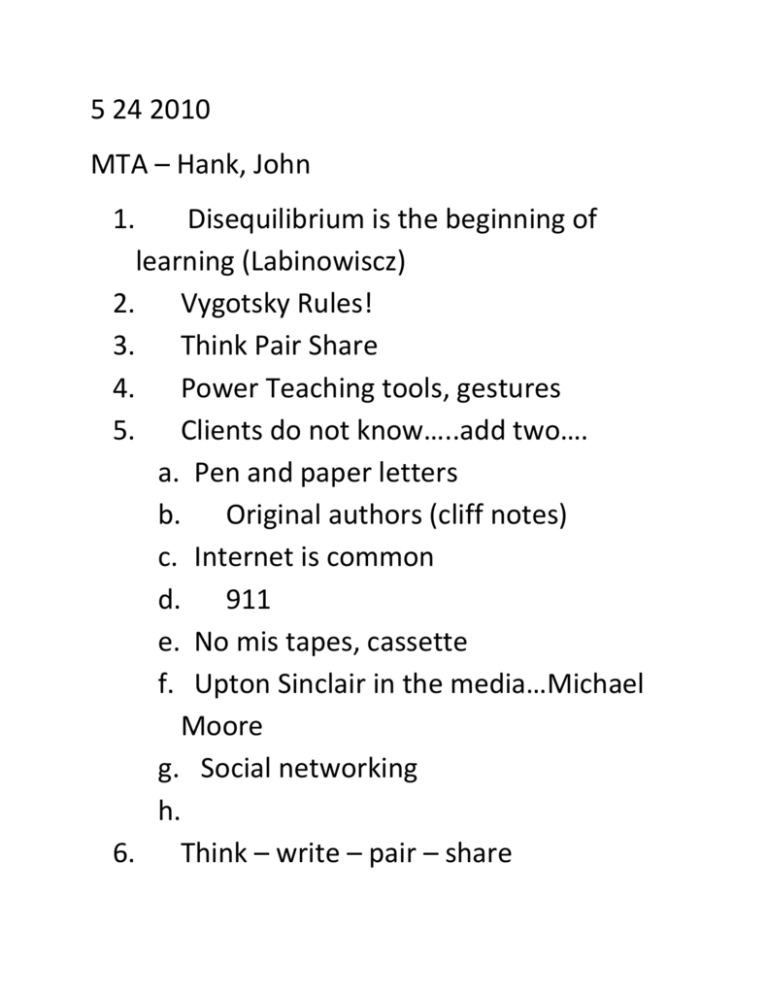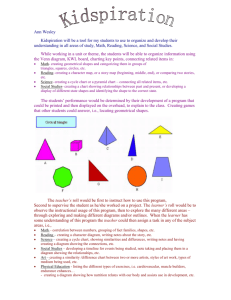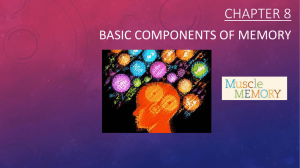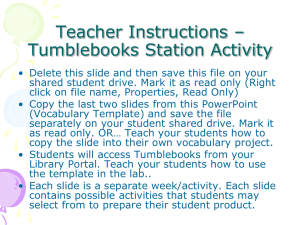5 24 Notes from class
advertisement

5 24 2010 MTA – Hank, John 1. Disequilibrium is the beginning of learning (Labinowiscz) 2. Vygotsky Rules! 3. Think Pair Share 4. Power Teaching tools, gestures 5. Clients do not know…..add two…. a. Pen and paper letters b. Original authors (cliff notes) c. Internet is common d. 911 e. No mis tapes, cassette f. Upton Sinclair in the media…Michael Moore g. Social networking h. 6. Think – write – pair – share 7. Differentiation of structure 8. Notebook organization – where are you? 9. Reality Check for Learning Styles write ups 10. Reading : Chapters 2 and 3 11. Science teachers – June 7th ppt more pictures than words, one brief activity; five slides – 12 minutes…. a.Kohler – Kim b. Kristine – Wertheimer c. Edwin Guthrie - Gwen 12. Chapter 5 – no reflection on this chapter 13. Theorists annotations 14. http://www.personal.psu.edu/scs15/id web/lessonplanning.htm 15. Lesson plan due for chapter 5 on the 7th see notes below….. 16. Study Skills Lesson begin 17. DLL due after teaching a. Do – Look – Learn – Goal i. Do – what did you do in the lesson? Details and be objective ii. Look – what did you see and hear during your teaching; for you and for the learners iii. What did you learn from your teaching: from the feedback iv. What is your goal for next time? 18. www.toread.com (check out the materials for KWL) To Do List 5/25 -SECD 580 Summer 2010 Read chapter 5 - This is due 6/7, - design a 15 minute lesson plan for chapter five format Robert Gagne Lesson plan format Chapter 2 and 3 reflections - use INTASC, - always APA style referencing DLL - Do, Look Learn - 1 page single spaced - INTASC standard - what you did - what you observed - what you learned while you were teaching - what are you going to do next time Theorist Presentation - Worthheimer SCIENCE FOLKS: KIM, GWEN AND KRISTINE - Powerpoint Presentation - no more than 5 slides - More pics than words - 12 minutes in length - All about the concept, not about the history - Annotate-major concepts what is really critical to this person and their contributions Write ups on Learning types Organized notebooks come to class on the 7th Mac’s please send documents as .rtf if submitting electronically 19. Closing story by Hugh Gallagher 20. 9 Step Lesson Plan based on Robert Gagne’s Conditions of Learning The 9 Step lesson Plan is based on shows Robert Gagne's events of instruction. Gagne believed that these events provide the necessary conditions for learning and serve as the basis for designing instruction. The table below shows Robert Gagne's events of instruction and an example lesson that follows it. Example Lesson: Be Inspired Using Kidspiration Objective: Students will create a compare and contrast diagram using Kidspiration software. Grade: 2 Event of Instruction 1. Gaining Attention Lesson Example Teacher tells learners how she has used Kidspiration in Rationale Giving background information creates the classroom. validity. Shows an example diagram made using Kidspiration on projection screen/TV monitor. The use of multimedia grabs the audience's attention. Asks learners questions about diagramming. Asking questions in the beginning creates an interactive atmosphere. 2. Informing the Learner of the Objective Teacher says, "Today I am going to show you how to use a multimedia presentation software called Kidspiration." Making learners aware of what to expect allows them to prepare to receive information. 3. Stimulating Recall of Prior Learning For this particular group of learners, they have learned previously about Mind Mapping and Schemata. Teacher associates this knowledge with lesson at hand. When learning something new, accessing prior knowledge is a major factor in the process of acquiring new information. 4. Presenting the Stimulus Teacher gives students stepby-step tutorial on using Kidspiration. (My eCoach Kidspiration Guide) and has installed Kidspiration software on their computers. The goal is information acquisition, therefore, the stimulus employed is written content and the actual software program. 5. Providing Learner Guidance Teacher demonstrates how to Learners are allowed to create a diagram on the video try the tools projection screen/TV monitor. demonstrated in partners Teacher shows students how on their computers. to use Kidspiration tools to Teacher uses "discovery type in text, add links, add learning" because symbols, use sounds, etc. learners are adults and it gives them the freedom to explore. Teacher facilitates the learning process by giving hints and cues when needed. Since the audience are teachers with some basic level of technology skills and the software program is easy to follow and understand, guidance is minimal. 6. Eliciting Performance Teacher asks students to demonstrate Kidspiration tools. Requiring the learner to produce based on what has been taught enables the learner to confirm their learning. 7. Giving Feedback Teacher gives immediate feedback to learners after eliciting responses. Regular feedback enhances learning. 8. Assessing Performance Assign a practice activity Create a diagram that focuses on Farm Animals. Teacher checks work. 9. Enhancing Retention and Transfer Teacher asks learners to create activities using Kidspiration for 2nd grade students. Independent practice forces students to use what they learned and apply it. Assessing such gives instructors a means of testing student learning outcomes. Applying learning in reallife situations is a step towards Mastery Learning. Teacher also charges learner with teaching another learner how to use Kidspiration. 21. 22. Event of Instruction 1. Gaining Attention Lesson Example Rationale 2. Informing the Learner of the Objective 3. Stimulating Recall of Prior Learning 4. Presenting the Stimulus 5. Providing Learner Guidance 6. Eliciting Performance 7. Giving Feedback 8. Assessing Performance 9. Enhancing Retention and Transfer 23. 24. Notes to do from last week Week 1 to bring to class on May 24th. 1. 4MAT (in class) Berniece McCarthy (Bring this write up to class in Week 2) Information about 4MAT links can be found in Resources for Week One on wiki. 2. Procrastination (on web and in class) http://discoveryhealth.queendom.com/questions/procrastination_short_ 1.html 3. http://www.web-us.com/brain/LRBrain.html Take the test…. a. What did you learn about yourself? b. Identify new terms in this test. c. How can you use this information to design curriculum? d. What are your insights about this type test? Did you look up the other steps in thinking like a genius?









